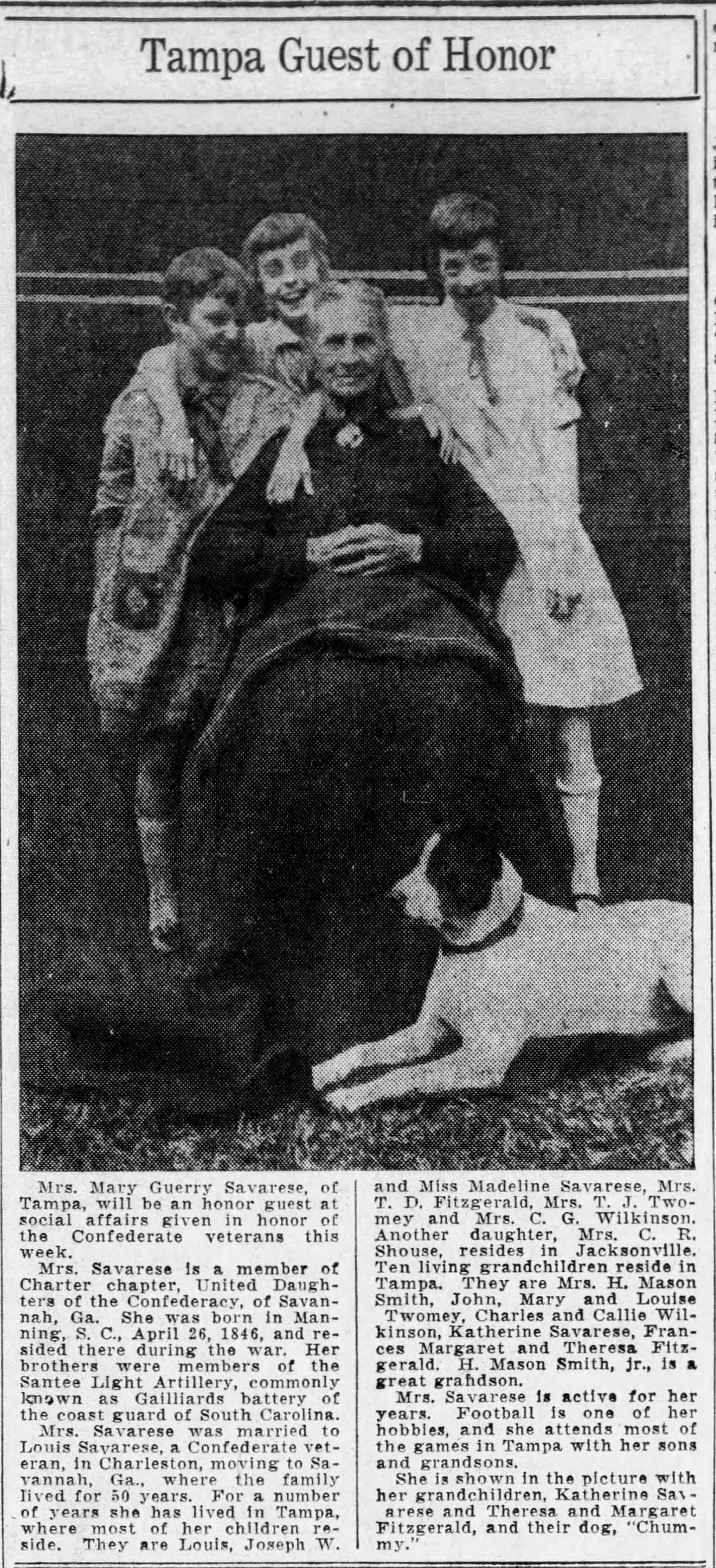I’m still working on chapter 1 of A Priest in Good Trouble, my biography of Father Louis J. Twomey, S.J., and, at the rate I’m going, I’ll be lucky to move onto chapter 2 by the end of the month. Blame Father Twomey’s maternal grandmother, Mary Louisa Guerry Savarese, a charming, intelligent, socially engaged Southern lady who loved going to football games with her children and grandchildren and was, by all accounts, an excellent markswoman. Mary Louisa, who died in 1931, has made my job more difficult, as I have learned that a key element of the family story that she passed on to Father Twomey was in fact a great whopper of a lie.
As I wrote in my article on Father Twomey for America, an important factor that contributed to Twomey’s effectiveness as a Southern voice for civil rights was that he was raised in a family that had great reverence for the legacy of the Confederacy (at least on his mother’s side; his father came over from Ireland after the Civil War). Although he had no patience for ideologues, he had endless compassion for people who, like him, had passively accepted white supremacy and needed to be brought out of their ignorance.
In particular, Twomey could relate to people who took pride in being descendants of Confederate veterans, because he often heard from his Grandmother Savarese that she had lost five brothers on the Confederate battlefields. Mary Louisa was a proud member of Savannah, Georgia’s charter chapter of the United Daughters of the Confederacy, which led efforts to raise monuments to Confederate soldiers. Her fervor for the so-called Lost Cause is evident in this excerpt from a letter to the editor of the Tampa Times that she wrote prior to Election Day, 1928, to encourage readers to vote for “Happy Warrior” Al Smith.
I was curious to know more about Grandmother Savarese’s story, so, when I began working on chapter 1 of A Priest in Good Trouble a few weeks ago, I purchased a month’s paid subscription to Ancestry.com. (If you are a paid subscriber to Matters Twomey, my gratitude goes out to you for making such expenditures possible.) To my surprise, I discovered that Mary Louisa Guerry Savarese only had one brother—not five. That brother, Francis Isaac Savarese, did die fighting for the Confederacy with the Santee Light Artillery. But the other four were fictions, as is clear from the information contained in the Guerry family Bible that was handed down to Mary Louisa. (I am indebted to Roderick Guerry, a cousin of Father Twomey’s whom I found via Ancestry, for information regarding the family Bible, which Mary Louisa passed on to one of her granddaughters.)
Why did Grandmother Savarese add four fictious members to her family’s roster of lives sacrificed for the Lost Cause? That is itself an intriguing story that I am excited to detail in chapter 1. It appears that Mary Louisa created the myth to boost her status as a widow raising five daughters and two sons in postbellum Savannah. Whereas other members of the United Daughters of the Confederacy might have lost two or three or four members of their immediate families in the war, she could claim that her family had shed an even more copious amount of blood under the Stars and Bars.
I doubt that Father Twomey’s life or work would have been different had he known that he had only one great-uncle, and not five, who died fighting for the Confederacy. Yet his grandmother’s story is important in that it shows the degree to which members of his family were invested in promoting the myth of Confederate glory. It also reveals something of the hardship that drove Mary Louisa to create a false identity—and the inner strength that led her to do what it took to survive in the war-beaten South. Twomey surely inherited something of her strength and dedication, even as he ultimately employed it to counter the lie of the Lost Cause.
In other news, last week I discovered a very important documentary, beautiful and moving, that made Father Twomey’s world come alive for me. A House Divided, co-produced by Xavier University of New Orleans in 1987 and narrated by the great James Earl Jones, includes interviews with many of Twomey’s close friends and associates, including Revius Ortique, Jr.; the Rev. Avery Alexander; Lolis Elie; J. Skelly Wright; and Twomey’s students and mentees Moon Landrieu and John P. Nelson, Jr. The film can be viewed on Xavier University’s website.
Next week, I am looking forward to giving two talks in New Orleans—a public talk on Father Ed: The Story of Bill W.’s Spiritual Sponsor at Holy Name on May 15 and a private talk on Father Twomey at the Round Table Club the following day. See my Dawn Patrol blog for details. If you are in New Orleans, I hope very much to see you at Holy Name.
I am also looking forward to meeting this week via Zoom with a publisher that is interested in A Priest in Good Trouble. As soon as there is any news on that front, I’ll share it here.
Thanks so much to all of you who are paid subscribers to Matters Twomey. I am treading uncharted waters as a mendicant biographer. It is very unusual for someone to undertake a project such as this without the support of an academic institution or a major publishing house.
Many thanks too to all of you who are sending up prayers for me as I write. I do need prayers, as writing is lonely work and requires a far greater amount of self-discipline than comes to me naturally. What keeps me going is my strong sense that Father Twomey’s story is a great one that needs to be told.






